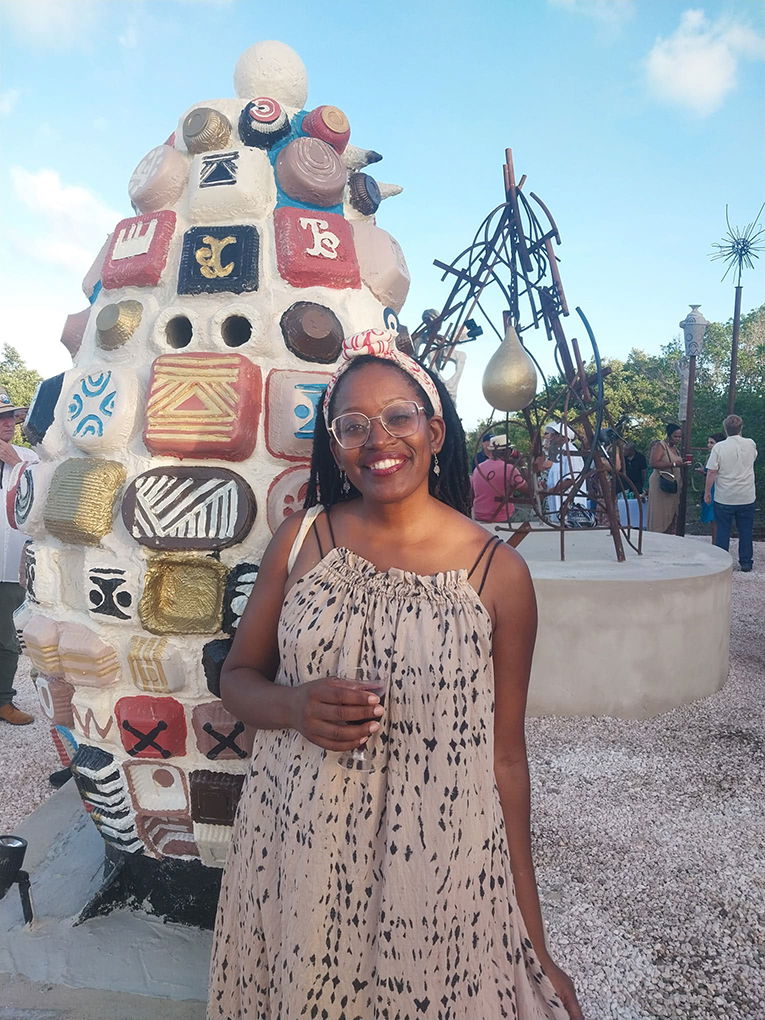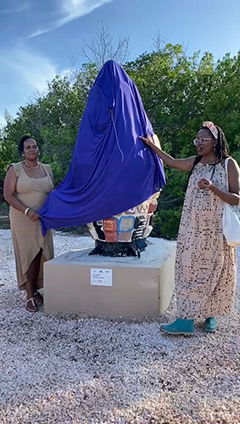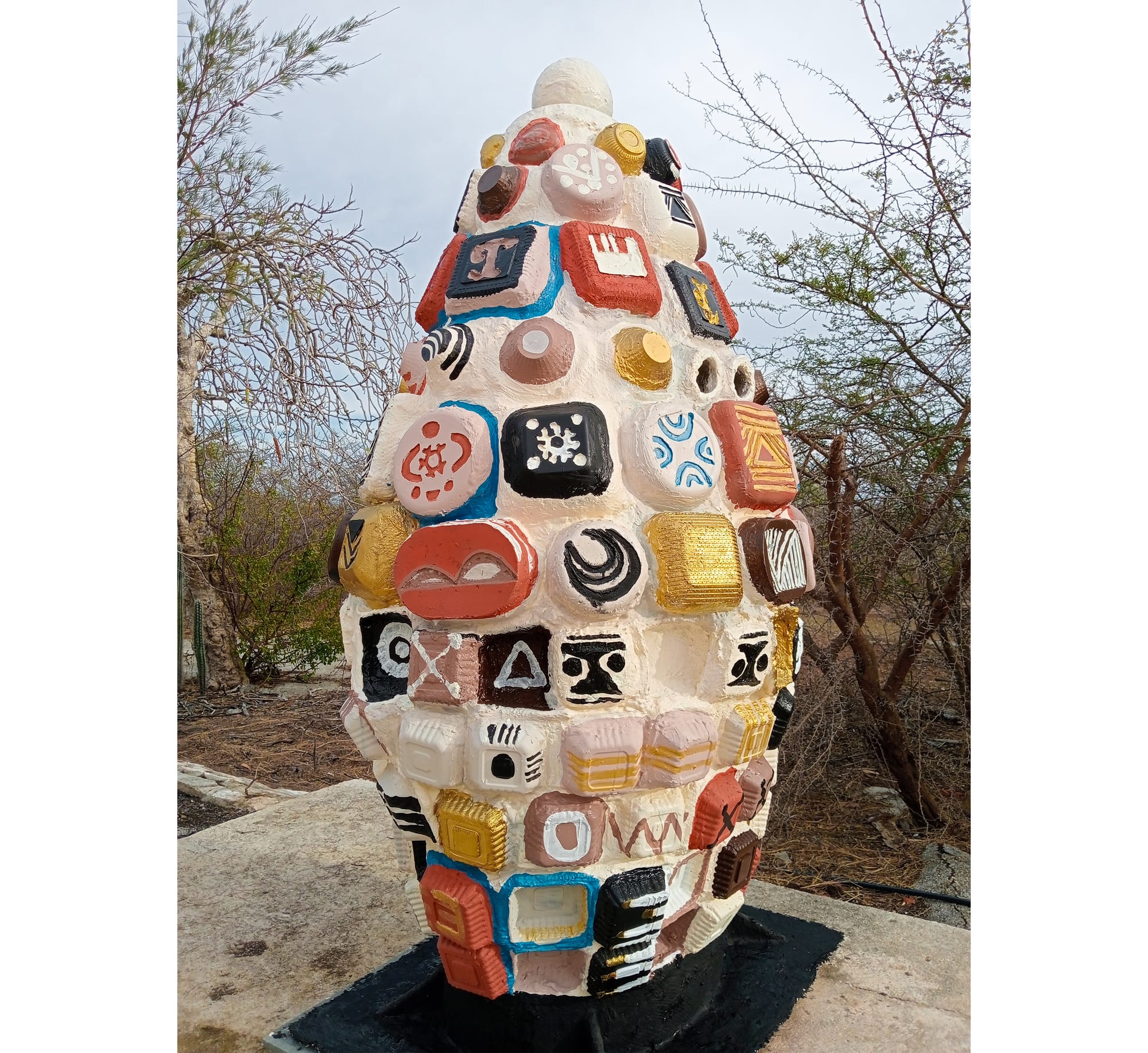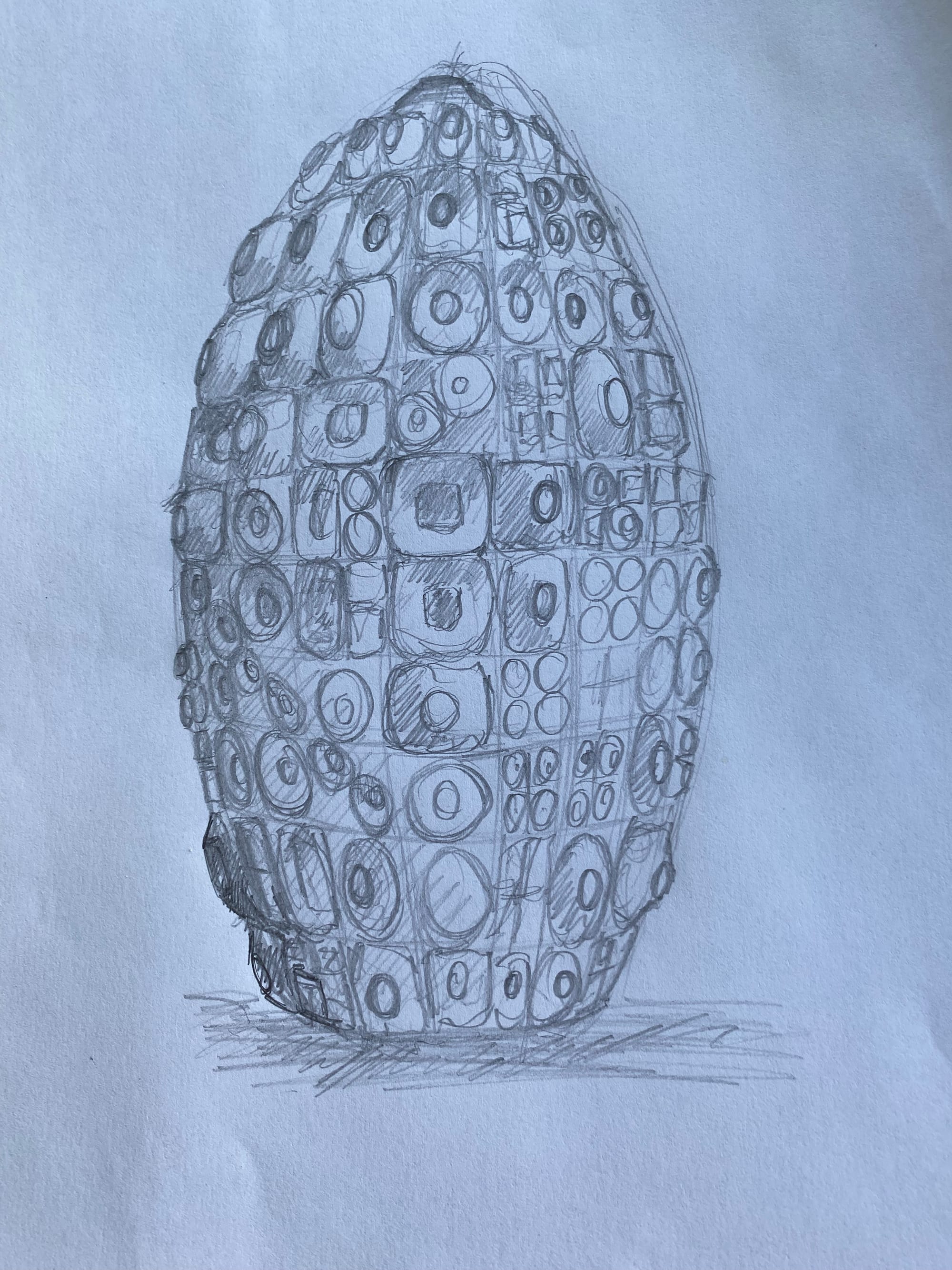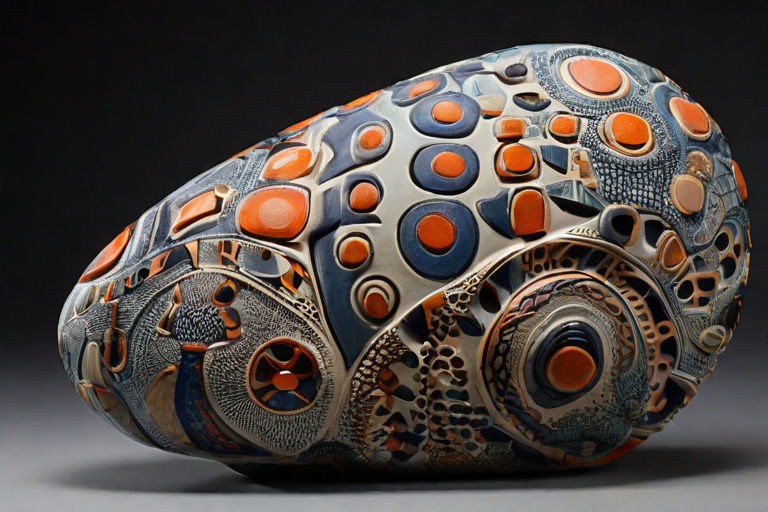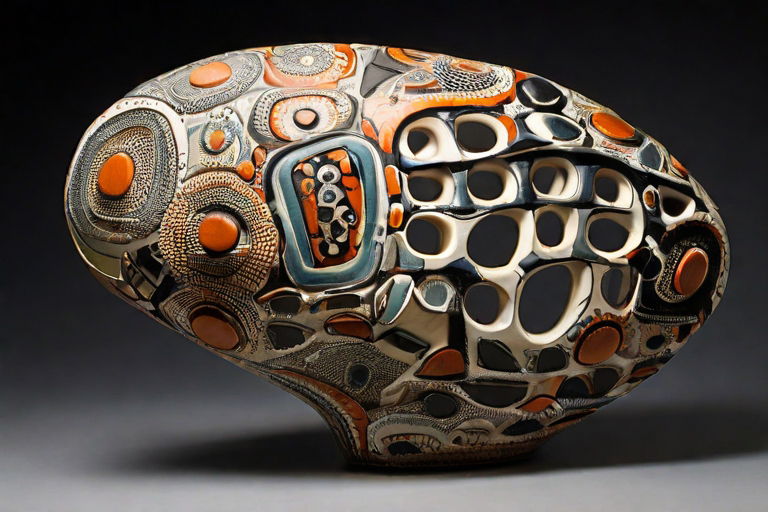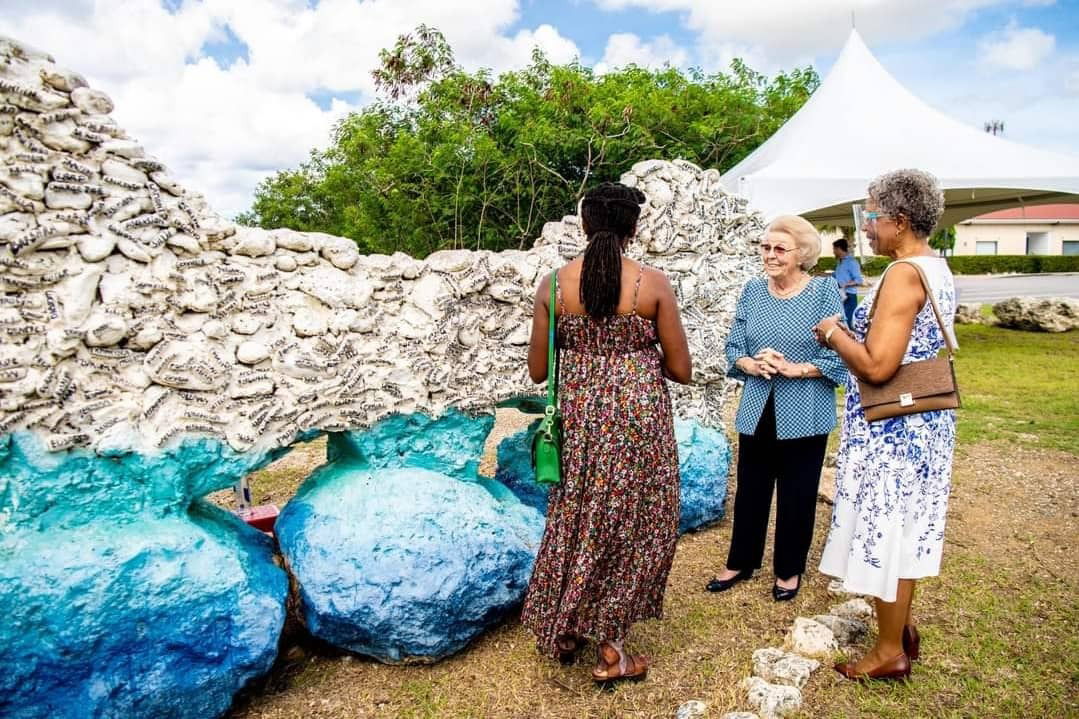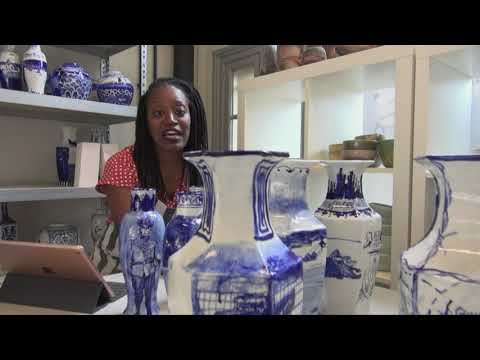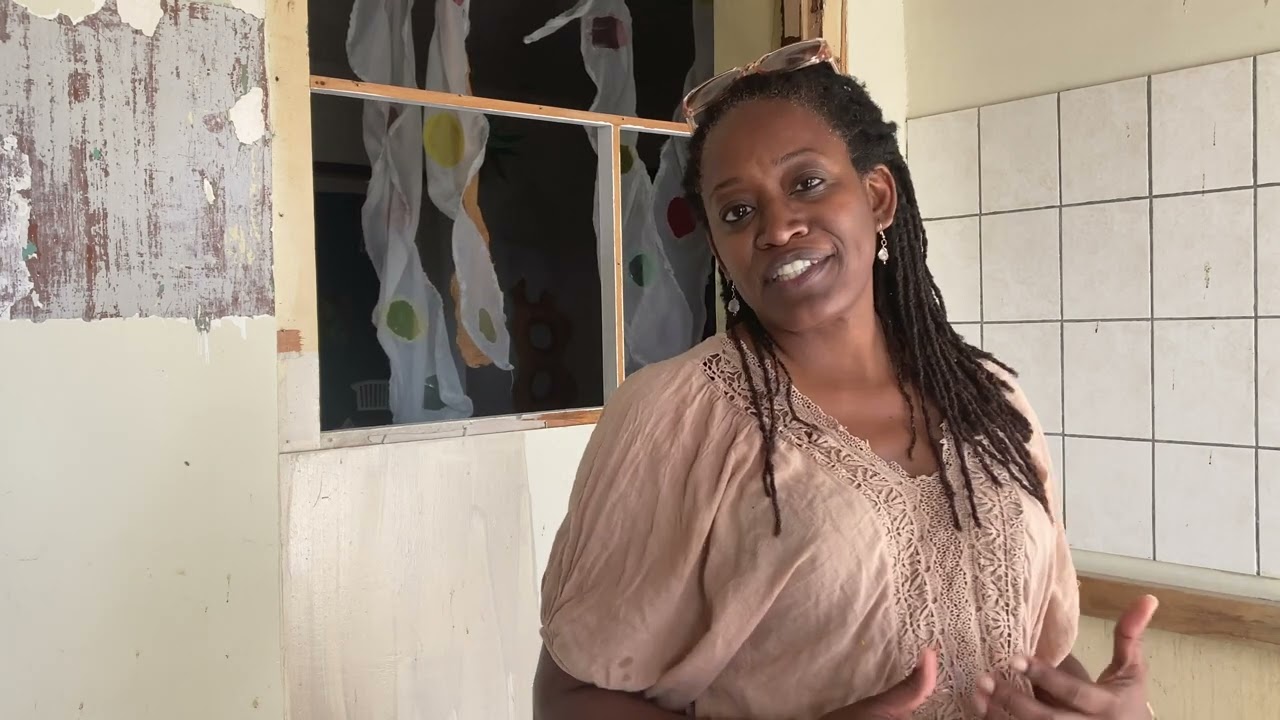On Saturday 11 January at 16:00, a special artwork will be unveiled on the coast of Pos Salu, near Sint Jorisbaai. This artwork represents the collaboration between artists Avantia Damberg and Maura Biava and was realised over a period of two and a half years.
Read MoreAVANTIA DAMBERG
ABOUT the artist
Avantia Damberg (1977) is a multidisciplinary visual artist based in Curaçao.
She started with video and animation art and currently focuses on art collage in the broadest sense of the word and on art in public space.
She is inspired by soundscapes, graphic design, typography and the history and nature of Curaçao . She is passionate about expressing this in installation art, land art or art in public space. She founded SKOR Kórsou, a foundation to promote art in the public and open space of Curaçao.
Damberg is known for Map of Curacao II at the public register "Kranshi", the iconic staircase of Otrobanda Colourful Steps and Curaçao Layers that hangs in the Wereldmuseum Amsterdam, the Netherlands.
She started with video and animation art and currently focuses on art collage in the broadest sense of the word and on art in public space.
She is inspired by soundscapes, graphic design, typography and the history and nature of Curaçao . She is passionate about expressing this in installation art, land art or art in public space. She founded SKOR Kórsou, a foundation to promote art in the public and open space of Curaçao.
Damberg is known for Map of Curacao II at the public register "Kranshi", the iconic staircase of Otrobanda Colourful Steps and Curaçao Layers that hangs in the Wereldmuseum Amsterdam, the Netherlands.
🌊urrent Breath
This collaborative piece is made by Maura Biava and Avantia Damberg.
The Braarudosphaeraceae family are unicellular coastal phytoplankton algae and the geometric shape of this micro-organism is the dodecahedron: 12 surfaces connected to each other, each surface having the shape of a pentagon. This pentagon is constantly repeated in nature in the shapes that the artists have as a source of inspiration: cacti, flowers, shells and the like. This shape, as an archetype for life, is the basis for the sculpture. The combination of water and oxygen brings life to our planet and these are the elements that make up the sculpture. The sculpture, placed on a pentagonal pedestal, consists of a metal dodecahedron, referring to the phytoplankton that provides oxygen in water. Water sprays upwards from the dodecahedron in the form of metal tubes. These tubes have air bubbles that are also cut from aluminum.
The Braarudosphaeraceae family are unicellular coastal phytoplankton algae and the geometric shape of this micro-organism is the dodecahedron: 12 surfaces connected to each other, each surface having the shape of a pentagon. This pentagon is constantly repeated in nature in the shapes that the artists have as a source of inspiration: cacti, flowers, shells and the like. This shape, as an archetype for life, is the basis for the sculpture. The combination of water and oxygen brings life to our planet and these are the elements that make up the sculpture. The sculpture, placed on a pentagonal pedestal, consists of a metal dodecahedron, referring to the phytoplankton that provides oxygen in water. Water sprays upwards from the dodecahedron in the form of metal tubes. These tubes have air bubbles that are also cut from aluminum.
The sculpture also has a spiritual meaning:
Genesis chapter 1: In the beginning God created the heavens and the earth. 2 Now the earth was formless and empty, darkness was over the surface of the deep, and the Spirit of God was hovering over the waters.The Spirit of God in Hebrew is referred to as "ruach," which signifies God's breath, spirit, or wind. This divine breath is what gives life; for instance, when God spoke, He breathed life into Adam, the first human created from dust. Initially, the Earth existed for millions of years, much like the ancient coastal phytoplankton algae, but it was devoid of life. It remained formless, empty, and dark as there was no light. God formed man from the soil, but Adam existed only as a lifeless body until God breathed His ruach into him.Water consists of three molecules: two hydrogen (H) atoms and one oxygen (O) atom, which is why it is commonly known as H2O. The presence of both hydrogen and oxygen, especially when combined with light, enables the existence of life.
This sculpture was commissioned by the Uniek Curaçao foundation, which, together with the Kunst in de Openbare Ruimte foundation, wants to combat the illegal dumping of waste in nature with art. It is the 5th sculpture of the new Pos Salu Open Air Sculpture Park.The project was made possible by SKOR Kòrsou and Stichting Uniek Curacao with financial support from the Mondriaan Fund and Cultuurfonds Caribisch Gebied.
Genesis chapter 1: In the beginning God created the heavens and the earth. 2 Now the earth was formless and empty, darkness was over the surface of the deep, and the Spirit of God was hovering over the waters.The Spirit of God in Hebrew is referred to as "ruach," which signifies God's breath, spirit, or wind. This divine breath is what gives life; for instance, when God spoke, He breathed life into Adam, the first human created from dust. Initially, the Earth existed for millions of years, much like the ancient coastal phytoplankton algae, but it was devoid of life. It remained formless, empty, and dark as there was no light. God formed man from the soil, but Adam existed only as a lifeless body until God breathed His ruach into him.Water consists of three molecules: two hydrogen (H) atoms and one oxygen (O) atom, which is why it is commonly known as H2O. The presence of both hydrogen and oxygen, especially when combined with light, enables the existence of life.
This sculpture was commissioned by the Uniek Curaçao foundation, which, together with the Kunst in de Openbare Ruimte foundation, wants to combat the illegal dumping of waste in nature with art. It is the 5th sculpture of the new Pos Salu Open Air Sculpture Park.The project was made possible by SKOR Kòrsou and Stichting Uniek Curacao with financial support from the Mondriaan Fund and Cultuurfonds Caribisch Gebied.
First Nation Creolisation
This collaborative piece (Avantia Damberg, Albert Kramer and 7.1 Giovanni Abath) beautifully symbolizes the interconnectedness of life and nature, drawing inspiration from both human and natural elements. The human hand, reaching towards water and sun, represents the essential components that sustain life on Earth. The water signifies nourishment and the flow of life, while the sun embodies warmth and energy, both crucial for growth and survival.First Nation Creolisation pays homage to the indigenous cultures that have long respected and revered these natural forces. By uniting these elements into a single artwork, the artists highlight the harmony and balance necessary for a sustainable future. This piece serves as a reminder of our shared responsibility to care for the environment and honor the ancestral wisdom that guides us in living harmoniously with the Earth. Through this artwork, the artists invite viewers to reflect on their own connection to nature and the ways in which we can all contribute to a more unified and sustainable world.
Curakaubá
The year 2023 was dedicated to the commemoration of 160 years of slavery. In this collaborative project called First Nation Creolisation, 7.1 Giovanni Abath, Albert Kramer and I chose the oppressed peoples of Curaçao during colonization as their theme, starting with the Caquetíos. Our sculptures are tributes to these groups and our heritage. I created a work in which I combined the decorations of the Caquetíos in their ceramics with those of African peoples that can be found in my DNA. Artist Albert Kramer helped me realising this sculpture as it is was the first time I worked with Acrylic One material. The shape has the language of Amerindian as African tribes. This resulted in a joint work that bears the name Curakaubá. Interesting is that many of the decorative elements of the peoples were identical.
Curacao Layers
Curaçao Layers consists of three parts. The work starts at the beginning: ceramics as a bridge between then and now. A recurring subject in my work is the graphic design on the ceramics of the Indigenous people of Curaçao, the Caiquetío, and the mark they made on Curaçao’s civilisation when the Spanish arrived. Ceramic is a durable material that can last long into the future, but which also reaches back thousands of years into the past. That is why the first part is made up of the graphic motifs that the Caiquetío people used on their ceramic vases and bowls, and on shards. The decorations were painted with iron oxide, a pigment they also used, as did the people before them, who created rock paintings with it. (Photo: World Museum Amsterdam)
The second part of my work is about freedom and ownership and features manumission letters printed on fabric. These letters were documents serving as evidence that you were a free man or woman. Likewise, they were also tangible proof that you had once been someone’s property and were not entitled to call yourself a human being until 1 July 1863, when slavery was abolished in ‘the West’. The manumission letters I chose are from the National Archives in Curaçao. The letters contain the surnames of former slave owners and enslaved people, names that are still common in Curaçao today. In the third part of the installation, have letters made of wood.
The second part of my work is about freedom and ownership and features manumission letters printed on fabric. These letters were documents serving as evidence that you were a free man or woman. Likewise, they were also tangible proof that you had once been someone’s property and were not entitled to call yourself a human being until 1 July 1863, when slavery was abolished in ‘the West’. The manumission letters I chose are from the National Archives in Curaçao. The letters contain the surnames of former slave owners and enslaved people, names that are still common in Curaçao today. In the third part of the installation, have letters made of wood.
This part consistsof the first and last couplets of Curaçao’s national anthem, which together make up the abbreviated version. As a people, if there’s one thing we all agree on, it is music, and particularly this song, a song of the people. The lyrics are still very uplifting. I have also used the national anthem in previous work. It's of wood because it is a flexible material that only becomes more beautiful and powerful with all that it endures. This reflects the development of the people of Curaçao.
the April Murder Vases
Curacao was a colony of the Netherlands from 1791 to 1954. In 1919 Curacao owned the largest oil refinery in the world. The oil was extracted in Maracaibo (Venezuela) and transported to strategical located Curacao by the Curaçaosche Scheepvaart Maatschappij, subsidiary of the Curaçoasche Petroleum Industrie Maatschappij
(Shell). There were about 400 Chinese stokers and other enginering personnel. The Chinese could do this work because they smoked opium and were addicted to opium, otherwise this work could not be done for long. The engine rooms could become 55 degrees Celsius, anyone not smoking opium would physically be written off at the a of 35. Despite their life-threatening work, they were treated worse than the other employees: they were paid less, their safety was less taken care of and they were forbidden to enter Willemstad, to get off the ship. In February 1942, the number of sea incidents on the CSM shipping route increased and Chinese people died. In addition, the Germans torpedoed ships with their U-boats (submarines). The fear this aroused among the Chinese, combined with their poor position within the company, led them to lay down their work en masse on February 24, 1942 in order to negotiate better working conditions. But it was war. The CSM requested the Curacao government to arrest these men on the basis of labor obligation; Strike was prohibited because of the importance of the fuel for the war.
This went on, the strikes and the camp they were put in became full. There was a shortage of space, food and sanitation. A very explosive situation ensued. On April 20, 1942, the chief inspector of the police, Van der Kroef, was ordered by the commander of the military police forces to select 85 Chinese and transfer them to another camp. They received help from the Immigration Service and 13 police officers and a number of guards from the CPIM. This separation resulted in a violent confrontation in which 12 Chinese were shot dead, 44 were injured and 3 more died of their wounds. After that, the Chinese are still separated. The dead were buried in the early morning of April 21, 1942, secretly and they were buried anonymously in the "graveyard of disgrace" Colebra Bèrdè. The Curacao government forbade the press to publish the incident. An independent investigation was not allowed and the incident dubbed "the Chinese conflict" was covered up. The Curacao government, nor the Dutch State have never accounted to the relatives of the murdered or injured Chinese in Curacao until the year 2022, 80 years later to date. These vases went into exhibition first in the Netherlands where they were made in 2021 and the year after the solo exhibiton took place on April 20, 2022 at the Curacao museum. If you would like to buy the catalogue book you can order it here, the soft cover is $8.99
https://www.blurb.com/b/11161482-the-aprilmoorden-vase-c
https://www.blurb.com/b/11161482-the-aprilmoorden-vase-c
In 2018 for the december edition the organisation of the Kaya Kaya streetparties (now Kaya Kaya Festival) in Otrobanda asked me to paint a new stairs replacing a stairs of 100 years old. This old stairs was more a hazard than a stairs. I made 5 designs and they picked the one with hexagon shapes. It is of all types of colors, primary colors but no red, secondary and tertiary colors. It's called 'With Taking Colorful Steps We Reach the Top'. For short Colorful Steps. We are all different but together we form a beautiful whole and together we can reach more than alone.
This work is also a collage in a landscape, the landscape being Ser'i Otrobanda and the main object being a geometrical shape. The hexagon shape is the best form to store quantity.
Since 2023 the stairs is tiled on the front for durablity.
Address: Van Lennepstraat, Otrobanda. https://maps.app.goo.gl/KEUHwztDehkiDTt49
This work is also a collage in a landscape, the landscape being Ser'i Otrobanda and the main object being a geometrical shape. The hexagon shape is the best form to store quantity.
Since 2023 the stairs is tiled on the front for durablity.
Address: Van Lennepstraat, Otrobanda. https://maps.app.goo.gl/KEUHwztDehkiDTt49
Map of Curacao I
The ‘Map of Curaçao’ (2014) is a paper installation consisting of two elements: surnames that came into existence on this island (the underlined names) plus surnames of people from this island who originally came from overseas.
Together they form the population of Curaçao.
I have used the names that still exist today. This map is not accurate and should not be seen as of any scientific historical value, but rather as an expression of how new identities have been brought about by freedom. Freedom – not only for the enslaved, but also the freedom to live on this island without being persecuted, or the freedom to build a new life which came about because of economic opportunities. All these factors made the Curaçao we know today, and Curaçao still attracts many nationalities to build a life here. Looking at the mix of names tells us this island is of the free, an island of new beginnings.
Thanks to Aubert Wiels, Elia Isenia, Jean Henriquez, the public library, The National Archives and the Mongui Maduro Library.
Just by hearing the stories of others, I was able to put this map together.
Together they form the population of Curaçao.
I have used the names that still exist today. This map is not accurate and should not be seen as of any scientific historical value, but rather as an expression of how new identities have been brought about by freedom. Freedom – not only for the enslaved, but also the freedom to live on this island without being persecuted, or the freedom to build a new life which came about because of economic opportunities. All these factors made the Curaçao we know today, and Curaçao still attracts many nationalities to build a life here. Looking at the mix of names tells us this island is of the free, an island of new beginnings.
Thanks to Aubert Wiels, Elia Isenia, Jean Henriquez, the public library, The National Archives and the Mongui Maduro Library.
Just by hearing the stories of others, I was able to put this map together.
.
Setting up Map of Curacao
at museum
Het Curaçaosche Museum
at National Archives The Hague
The latest paper Map of Curaçao was shown in 2021 in the National Archives of the Netherlands in The Hague.
Map of Aruba
In 2016 during my artist-in-residency at Ateliers '89 I made the Map of Aruba
Map of Curacao II
In the context of the abolition of slavery with the theme of 'freedom' 150 years ago in 2014, the installation Map of Curaçao I was created: a map of Curaçao made up of surnames at the location where the family name comes from. In the past, most enslaved had their African surnames diminished and by the abolition of slavery, a non-existent surname was required by law to be entered and registered with the population register. The first edition is from paper and this second work is permanent, made from ceramics. It hangs in the public registry office 'Kranshi'.
This is a work about identity and heritage and I did research for it which made me really dig into Curaçao and learn and discover new insights about Curaçao.
This is a work about identity and heritage and I did research for it which made me really dig into Curaçao and learn and discover new insights about Curaçao.
Map of Curaçao III
The third edition of Map of Curacao is commissioned by Sculpture garden Blue Bay Curacao foundation. As it is a sculpture for outside I chose materials from outside: corals and stones. This art work was made with the help of Arnold J. Bakker and Rina Rojer.
The princess of the Netherlands, princess Beatrix was invited by the foundation to visit as she loves art and is a sculptor herself. She made very interesting comments and asked great questions such as: is the back of the sculpture also part of the work? As it doesn't have the names and it's after all about the populations, I told her not really, but Arnold Bakker commented yes, because that's the island before it got populated. Which is very true.
The princess of the Netherlands, princess Beatrix was invited by the foundation to visit as she loves art and is a sculptor herself. She made very interesting comments and asked great questions such as: is the back of the sculpture also part of the work? As it doesn't have the names and it's after all about the populations, I told her not really, but Arnold Bakker commented yes, because that's the island before it got populated. Which is very true.
NEWS
Duo-exhibition Track & Traced Saturday 11 of January til March 15 There will be also Meet & Greets (Saturdays) and one more workshop: Portrait Painting Workshop Follow more on the socials (facebook and instagram) for updates
Read MoreMy first youtube channel, not only about my art but mostly about the special buiding I make my art in, with all the other activities around it.
Read MoreContact
- 34 Brakkeput Abou, Willemstad, Curaçao
- Atelier Landhuis Nooitgedacht
- +599-95128265 - Avantia Damberg Artist
- avantiadamberg@gmail.com
- Send a whatsapp message
